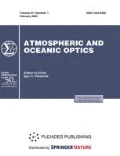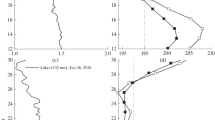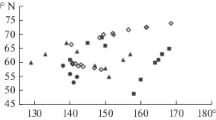Abstract
Lidar observations at Siberian Lidar Station (SLS) of the Institute of Atmospheric Optics, Siberian Branch, Russian Academy of Sciences, in Tomsk (56.5° N; 85.0° E) showed the presence of stratospheric aerosol layers, descent of air masses, and deficit of ozone over the city during winter 2017–2018. Aura OMI/MLS data indicated that the total ozone (TO) content and NO2 content in the stratosphere over northern Eurasia, as well as the temperature in the stratosphere, were significantly lower than normal in December 2017–January 2018. Analysis of back trajectories and integrated (over profile) TO showed that the dynamic disturbance of the Arctic stratosphere in December 2017 led to the extrusion of cold air masses with excessive reactive chlorine content (in view of NO2 deficit) beyond the Arctic circle and their intrusion into the stratosphere of Tomsk. Seemingly, they were exposed to solar radiation in the stratosphere over Tomsk and, staying spatially isolated, became chemically disturbed. This state is similar to the state of the springtime Arctic stratosphere, where ozone is intensely destroyed until the final warming.






Similar content being viewed by others
REFERENCES
S. Solomon, “Stratospheric ozone depletion: A review of concepts and history,” Rev. Geophys. 37 (3), 275–316 (1999).
T. Von Clarmann, “Chlorine in the stratosphere,” Atmosfera 26 (3), 415–458 (2013).
O. E. Bazhenov, “Increased humidity in the stratosphere as a possible factor of ozone destruction in the Arctic during the spring 2011 using Aura MLS observations,” Int. J. Remote Sens. 40 (9), 3448–3460 (2019).
Y. Jiang, Y. L. Yung, and R. W. Zurek, “Decadal evolution of the Antarctic ozone hole,” J. Geophys. Res. D 101 (4), 8985–8999 (1996).
R. V. Sanders, S. Solomon, J. P. Smith, L. Perliski, H. L. Miller, G. H. Mount, J. G. Keys, and A. L. Schmeltekoph, “Visible and near-ultraviolet spectroscopy at McMurdo station, Antarctica: 9. Observations of OClO from April to October 1991,” J. Geophys. Res. D 98 (4), 7219–7228 (1993).
S. Solomon, R. W. Sanders, and H. L. Miller, Jr., “Visible and near-ultraviolet spectroscopy at McMurdo station, Antarctica 7. OClO diurnal photochemistry and implications for ozone destruction,” J. Geophys. Res. D 95 (9), 13,807 (1990).
C. S. Singleton, C. E. Randall, M. P. Chipperfield, S. Davies, W. Feng, R. M. Bevilacqua, K. W. Hoppel, M. D. Fromm, G. L. Manney, and V. L. Harvey, “2002-2003 Arctic ozone loss deduced from POAM III satellite observations and the SLIMCAT chemical transport model,” Atmos. Chem. Phys. 5, 597–609 (2005).
G. L. Manney, Z. D. Lawrence, M. L. Santee, W. G. Read, N. J. Livesey, A. Lambert, L. Froidevaux, H. C. Pumphrey, and M. J. Schwartz, “A minor sudden stratospheric warming with a major impact: Transport and polar processing in the 2014/2015 Arctic winter,” Geophys. Rev. Lett. 42, 7808–7816 (2015).
O. E. Bazhenov, “Quasi-biennial oscillation of the total ozone and ozone concentrations at separate altitude levels over Arctic and Tomsk according to TOMS, OMI, and MLS observations,” Int. J. Remote Sens. 36 (12), 3033–3040 (2015).
A. J. Charlton and L. M. Polvani, “A new look at stratospheric sudden warmings. Part I. Climatology and modeling benchmarks,” J. Climate 20 (3), 449–471 (2007).
J. Rao, R. Ren, H. Chen, Y. Yu, and Y. Zhou, “The stratospheric sudden warming event in February 2018 and its prediction by a climate system model,” J. Geophys. Res. 23 (123) (2018). https://doi.org/10.1029/2018JD028908
T. Flury, K. Hocke, A. Haefele, N. Kampfer, and R. Lehmann, “Ozone depletion, water vapor increase, and PSC Generation at midlatitudes by the 2008 major stratospheric warming,” J. Geophys. Res. D 114 (18302) (2009). https://doi.org/10.1029/2009JD011940
G. L. Manney, Z. D. Lawrence, M. L. Santee, N. J. Livesey, A. Lambert, and M. C. Pitts, “Polar processing in a split vortex: Arctic ozone loss in early winter 2012/2013,” Atmos. Chem. Phys. 15, 5381–5403 (2015).
G. L. Manney and Z. D. Lawrence, “The major stratospheric final warming in 2016: Dispersal of vortex air and termination of Arctic chemical ozone loss,” Atmos. Chem. Phys. 16, 15371–15396 (2016).
V. D. Burlakov, S. I. Dolgii, and A. V. Nevzorov, “Modification of the measuring complex at the Siberian Lidar Station,” Atmos. Ocean. Opt. 17 (10), 756–762 (2004).
Author information
Authors and Affiliations
Corresponding authors
Ethics declarations
The authors declare that they have no conflicts of interest.
Additional information
Translated by O. Ponomareva
Rights and permissions
About this article
Cite this article
Bazhenov, O.E., Nevzorov, A.A., Nevzorov, A.V. et al. Disturbance of the Stratosphere over Tomsk during Winter 2017/2018 Using Lidar and Aura MLS/OMI Observations. Atmos Ocean Opt 33, 622–628 (2020). https://doi.org/10.1134/S1024856020060068
Received:
Revised:
Accepted:
Published:
Issue Date:
DOI: https://doi.org/10.1134/S1024856020060068




